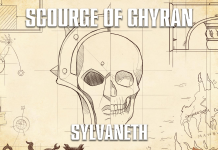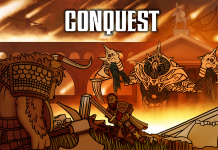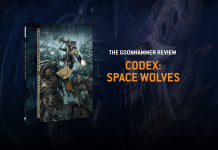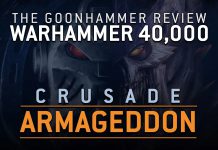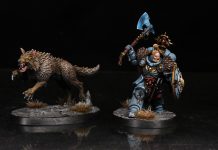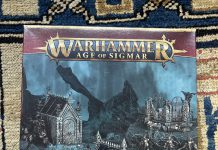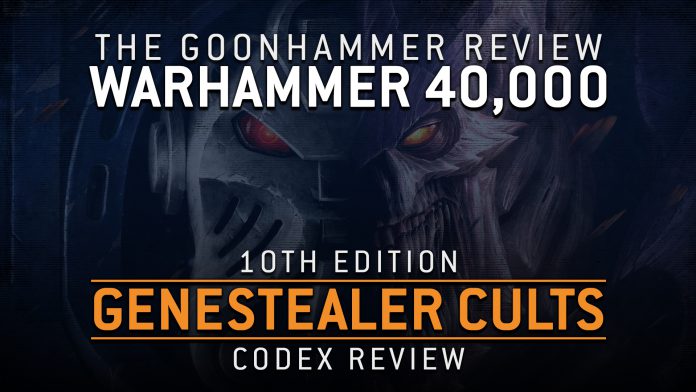Welcome, Brethren, to our review of Codex: Genestealer Cults. If you’re searching for a better life after years of toil under the yoke of the Oppressor, we are here to share the good news: the Star Children are coming. With five new detachments, a new unit, and a whole host of datasheet changes, join us; our time is nigh!
As always, we would like to thank Games Workshop for providing us with a review copy of the Codex.
Army Overview
Representing a guerilla force preparing in the shadows before bursting forth with devastating strikes from every angle, Genestealer Cults are an insidious force of human-alien hybrids with industrial tools and alien cunning. GSC units are hard-hitting, fragile, and appear wherever needed to execute their plans. Most units in the Codex have access to mobility special rules like Deep Strike or Scouts, and their army rule allows units to return to the battle after being destroyed, forcing the opponent to come forward to root out the insurgency or risk drowning in a sea of the Four-Armed Emperor’s faithful.
We think the following are five standout features of this book:
- Five thematic detachments. The detachments here do an excellent job of capturing the feel of multiple cult archetypes and playstyles.
- Sweeping datasheet changes across the range open up new balance and build possibilities.
- Better support for melee. In the Index, your choice was basically “a squad of Aberrants” or “nothing” on this front, and there’s much more variety now.
- The army rule returns largely unchanged. This has some interesting interactions with the new detachments, but as we’ll discuss it also leaves one of the most frustrating aspects of the index intact.
- A major shift in how much stuff you get – hopefully. Bluntly, this faction will collapse like a flan in a cupboard without massive points cuts across the board.
What Else Is Coming?
As always, Crusade is getting its own article next Tuesday, and in the next few weeks we’ll also be publishing an Opponent’s Guide to this faction, as people loved the Chaos Space Marines one. For the two Codexes released today, we’re also holding off on Army Lists until the final points are out – both feel like the magnitude of change is just too great for either book points or MFM points to provide a realistic framework.
Army Rules

GENESTEALER CULTS armies gain access to the Cult Ambush ability, which appears on non-vehicle, non-character datasheets. As we’ll discuss, this is an incredibly powerful ability but has significant drawbacks both in gameplay terms and the overall player experience.
Cult Ambush
Every time a unit with the Cult Ambush ability is destroyed, roll a d6, adding one if the game is in the first or second battle round. On a 5+ you can place a new copy of the unit into Cult Ambush, complete with its One-Shot weapons restored (but not its characters). Additionally, you place a Cult Ambush token (colloquially known as “blips”) anywhere on the board more than 9” from enemy units.
At the end of your opponent’s next movement phase, each blip on the board allows a unit to be set up wholly within 3” of the blip token and more than 9” from enemy models. Your opponent can destroy blips by ending any kind of move within 9” of the token.
This rule is thematic in that it represents the unknowable forces of the cult springing from hiding to join the fight, and forces your opponent to take control of the board to avoid fighting new enemies in every quarter. Unfortunately it’s often infuriating for your opponent, as with a bit of luck they may find they’re fighting 3000+ points of GSC units and be overwhelmed. Conversely, it also means that in a multi-game tournament a GSC player should expect at least one game in which almost none of their units return to Cult Ambush, so the potential for frustration is high for both sides.
Wings: I feel like this has probably gone too far in reducing the power of this mechanic, particularly now (as we’ll see) that the lethality of the main Battleline units has gone down a bit. I’m putting a marker down that a future Dataslate is going to introduce some sort of bonus to this, perhaps a bonus to rolls while you have no Ambush counters on the table.
One notable change from the index is that the bonus to the roll for <Battleline> units is gone. Combined with the datasheet changes, our hope is that this both enables and incentivizes more variety in lists. Index costs were designed to disincentivize an MSU board-control style because of the inherent power of respawning units, and top GSC lists often used their access to Astra Militarum units to boost their early game board presence and action economy. That brings us to our next major change…
Brood Brothers
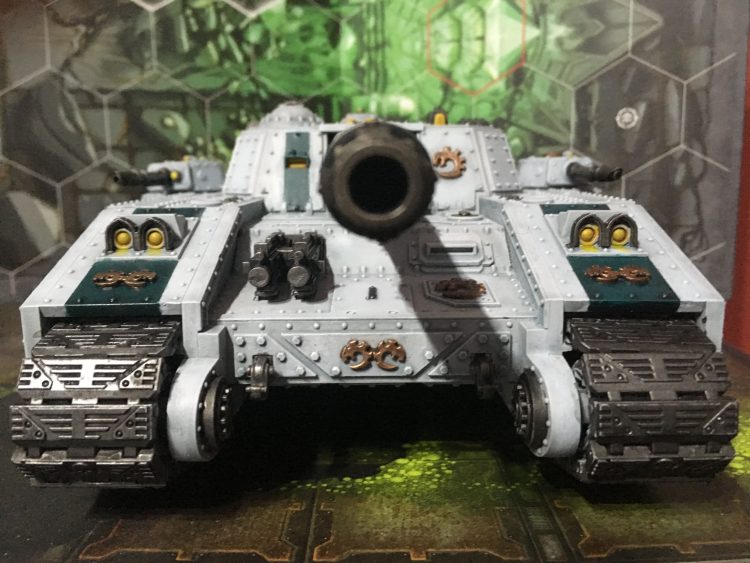
The Brood Brothers army rule in the index previously allowed up to 500pts of ASTRA MILITARUM units to be included alongside a GSC force. That army rule is now moved to the dedicated Brood Brother Auxilia detachment, which allows up to 1000pts of Astra Militarum units and has rules focused on their interactions with traditional GSC units. Unfortunately for Cyclops Demolition Vehicle enthusiasts everywhere, Brood Brothers are no longer available outside one dedicated detachment.
Detachments
Genestealer Cults get a fairly generous allocation of detachments, getting five to work with. These include a returning version of the (very good) Index detachment, two that feel more melee-focused (one horde-style, one chunky style), and two that encourage a more mechanised setup – one using Trucks and bikes, and the other importing Militarum tanks.
Host of Ascension
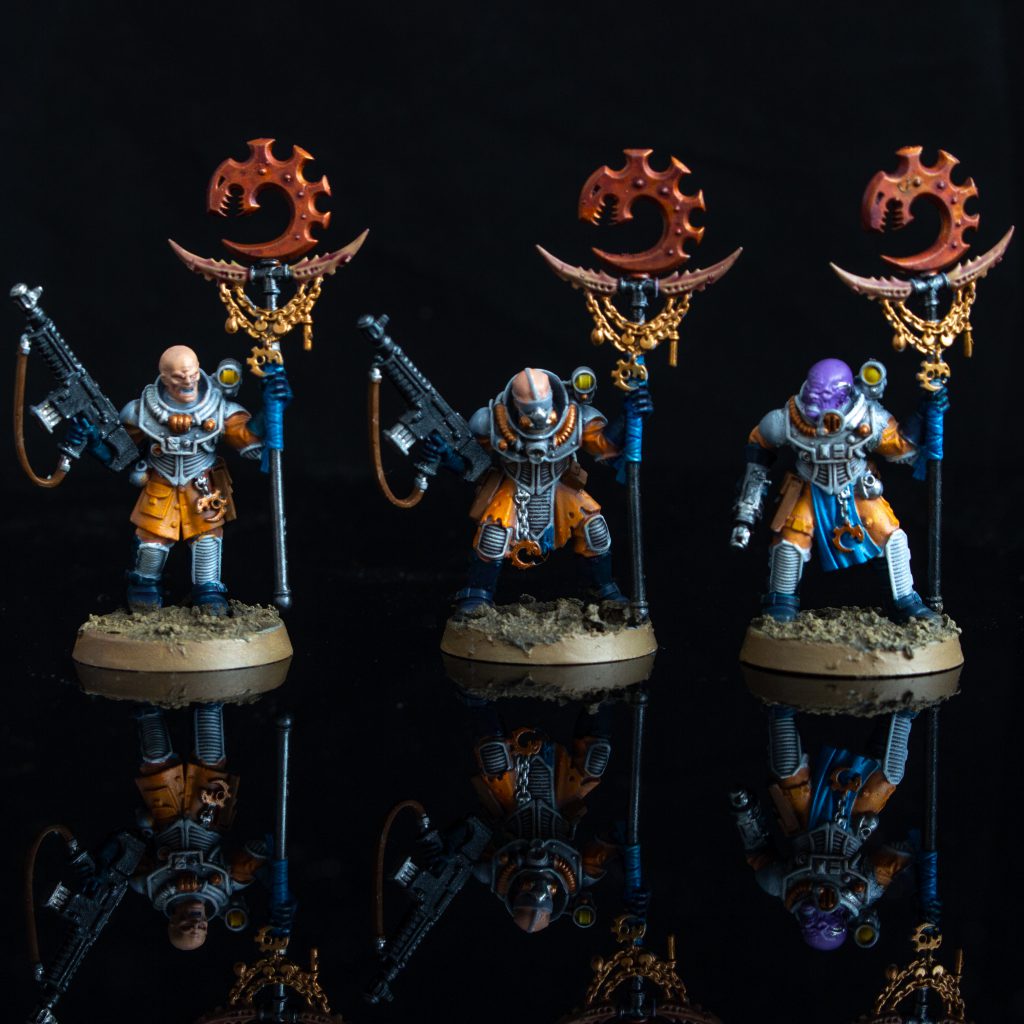
This is a rework of the index detachment. The detachment rule remains the same, but the stratagem selection is significantly different. The overall impact is fewer (but still devastating) alpha strikes and a higher dependence on Cult Ambush for repositioning. The biggest change is that Return to the Shadows has been reworked, which will considerably alter how the detachment plays on the table. Additionally, there are more tools for melee units here, encouraging a bit of diversification away from the “all guns all the time” style that typified the index, and providing a boost to the board-control pieces that you’ll almost certainly be taking now that access to Brood Brothers is confined to their specialist detachment.
Detachment Rule – A Perfect Ambush
Unchanged from the Index, units set up on the battlefield as Reinforcements get [Sustained Hits 1] and [Ignores Cover] until the end of your next fight phase. Note that this also applies to units which arrive from Cult Ambush.
Enhancements
Three new enhancements here, plus one returning favorite.
A Chink In Their Armour: Each time the bearer is set up as reinforcements, the bearer’s unit gains Lethal Hits on ranged weapons until the end of your next Fight Phase.
Combined with Sustained Hits from the detachment rule, Crits on 5’s from the new Primed and Readied stratagem, and full hit rerolls from the Primus, this lets you turn a single squad’s output way up to terrifying levels. However, the datasheet changes to neophytes and acolytes make this less powerful than it would be in their Index incarnation. Getting the unit back into reserves to use it a second time is much harder now as well, so while this is an incredible tool you’ll often only get to use it once.
Our Time Is Nigh: Once per battle +2 to a charge roll for the bearer’s unit. This opens up the option to either attempt a 7” charge out of deep-strike or make an on-board charge more reliable. Nice to have.
Assassination Edict: Each time the bearer’s unit makes an attack that targets a character unit, add 1 to the hit roll. This is quite good, since our best weapons normally hit on fives and important enemy units often have leaders attached.
Prowling Agitant: Returning unchanged from the index, Prowling Agitant is still useful for keeping lone operatives out of reach or dancing back into transports (particularly now that Goliath Trucks are priced more appropriately).
Stratagems
Coordinated Trap returns to give two units +1 to wound against the same target for 2CP. The loophole that previously allowed you to select any two units in the fight phase when you really just wanted it on one has been closed; now both units must be eligible to fight the targetted enemy unit.
Tunnel Crawlers has been changed from the index to a 3” deep-strike for Battleline units or a 6” arrival for other deep-strikers. This is not a major change, since if you’re using this it’s almost certainly to get demo-charge acolytes in bombing range or steal a point with Neophytes. The overall utility here is reduced, since demo charges have been toned down considerably.
Primed and Readied: Critical Hits on 5+ for any unit in the shooting or fight phases, for 1CP and it’s a battle tactic. This is the sauce that will make the detachment work. With the detachment rule providing sustained hits and several characters and an enhancement providing lethal hits, press this button when things need to die. Note that this does not require you to have arrived from reinforcements this turn; it just works. Ranged units with a Benefictus, or melee units with a Biophagus can use this every time they activate, and makes a Biophagus + Primus melee combination a real consideration as a rapid-ingress threat.
Lying in Wait: This one is the first of many variations on the blip-management shell game, with each detachment having its own version. Select a Battleline unit in Cult Ambush, and set it up anywhere wholly within 6” of a cult ambush marker and not within Engagement Range of the enemy. This allows you to extend the threat range of your ambush markers, but you will often be dependent on enemy movement and your own Nexos or Iconward abilities to get blips into a position to take advantage of it. In the previous index style this would feel silly, as there was often no reason to be aggressive with blip placement. However, it’s more important to be aggressive with blips now because getting back into reserves from a safe spot is no longer an option due to the new way Return to the Shadows works.
Return To The Shadows: Changed from the index version, this previously allowed two battleline units to return to reserves at the end of the opponent’s turn. Now it allows one infantry unit to return to reserves after an enemy unit resolves shooting attacks against it in the Shooting Phase. In practice you will almost never get to use this against a competent opponent, but the threat of it will prevent your opponent from shooting at key units like your Chink In Their Armour holder unless they’re sure they can kill it all at once. Similarly, it will dictate where they position their melee units as they’ll need a way to silence your Neophytes without letting you reactivate the enhancement.
Wings: I’m a bit higher on this – wiping whole Neophyte units in one activation just isn’t something every opponent can do, and because of the power being concentrated in the special weapons and Characters, the threat of reloading that is quite potent. You could also combo it with an Aberrant unit using Our Time is Nigh to land their first charge – even at their slightly reduced durability, almost nothing is going to insta-wipe them.
A Deadly Snare: A dice roll to do mortals to an enemy unit that declared a charge against you, doing somewhere between 0 and 3 mortals depending on how you roll. Note that the damage happens when the charge is declared but before it’s rolled. This is situational to prevent charges from low-health units (say, the survivors of a Saboteur’s mine trying to finish her off) or punish positioning in which chaff models are in front but special weapons are in the back, forcing a choice between a longer charge or losing key models. You won’t use it often, but it can be back-breaking when it comes up.
Xenocreed Congregation
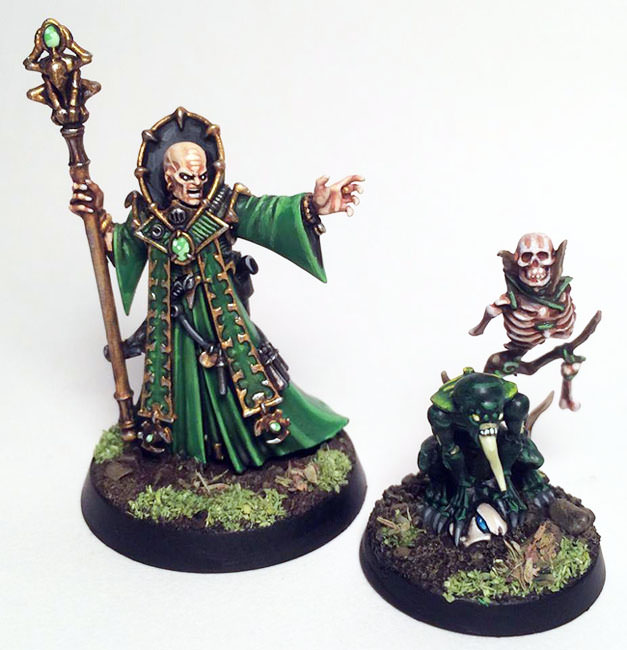
The Xenocreed Congregation puts the focus firmly on the rank-and-file followers of the cult and their spiritual leaders. Neophytes, Acolyte Hybrids and Hybrid Metamorphs cover the former, while the Primus, Magus and Iconward are a particular focus on the latter (though some buffs just work with any Character). This naturally pulls towards an Infantry-heavy force, which means a bit of overlap with the Host of Ascension in terms of the supported units, but the greater focus on melee gives this something of a distinct flavour, and it also has some excellent Cult Ambush support to squeeze the most value out of your units.
Detachment Rule – Unquestioning Fanaticism
Your units of the three supported Infantry get to re-roll Advances and Charges as long as they are being lead by a CHARACTER, and if that Character is a Magus, Primus or Iconward, they get a 3+ Feel No Pain to protect them from being sniped out. This obviously pulls towards melee units, and really wants you to be able to Advance and Charge for maximum value. Happily, this detachment has multiple sources of that to work with – so let’s take a look.
Enhancements
All of these can only be taken on a Primus, Magus or Iconwards. Functionally, that’s going to mean a Primus or Iconward a lot of the time, because the Magus is still baaaad.
The first of these, Gene-sire’s Reliquant is also pretty bad, letting you re-roll Battle-shock tests. This is very fringe in utility – Genestealer Cults units have a strong tendency towards a binary of being dead or alive, and although picking up some protection from Battle-shock abilities can be good, it’s very inconsistent. It’s at least cheap at 10pts – but the other three are all great, so you’re very unlikely to ever take it.
Next is your damage boost, Denunciator of Tyrants. This gives the bearer’s unit +1 to Hit and Wound against Character units, and given that includes anything with a Leader that’s an exceptional buff. This is the one big way this detachment can boost its shooting, and it feels like you take this on a Primus with a full Neophyte unit pretty much 100% of the time.
Deeds that Speak to the Masses is also a near auto-take if you’re going in on this – as long as the bearer is on the Battlefield, you can re-roll one Cult Ambush roll for a Battleline unit per turn. Quite honestly, the book as a whole needed access to a bit more of this, and it being here is a genuine draw. It’s also worth noting that it’s per-turn, so if you take throwaway Acolyte units to hurl suicidally into combat, you might be able to get even more value from it. This also might be one you chuck on a Magus who sits on a home objective, as she does more there than the other two Characters do.
Finally, Incendiary Inspiration lets the bearer’s unit Advance/Charge. Put this on an Iconward with Metamorphs, no questions asked.
Stratagems
The first Stratagem here is a “revenge” one, and while these generally haven’t been great, here I think there’s actually some legs. Vengeance for the Martyred triggers when your opponent destroys one of your Characters in their Shooting or the Fight Phase, and gives all your Hybrids re-roll 1s to hit against the culprit for the rest of the game, or full re-rolls if the destroyed Character was one of the big three. The reason this has some appeal is that it mitigates the issue with your second wave being less effective than your first – your Primuses are what give you your re-rolls, but tend to die when the opponent hits back. With this, if the opponent takes revenge with one of their key units, then you can tee up re-rolls for when your unit comes back to continue the cycle of destruction.
If you just want to murder things straight up, Frenzied Devotion is your friend. This gives non-CHARACTER models in a Hybrid unit +1 to WS and A in the Fight Phase (and Hazardous), which is really nasty for 1CP, giving back a hint of the old brutality of Acolytes in 8th. Now you can have three melee weapons per 5, this can be nasty with even small units of Acolytes, and on full units of Acolytes or Metamorphs this can be staggeringly brutal. A definite draw to the detachment, and something to actively build into your plans. Small Acolyte units can project some great counter-charge threat, and I think 10-model Metamorph units with an Iconward are already what you want.
I mentioned extra Advance/Charge earlier, and Tireless Fervour gives you that for Hybrids (Fall Back/Charge too), with the additional upside that if you target an enemy unit that’s in Engagement Range of one of your CHARACTERS, you get a free Charge Re-roll. This is all particularly nice because you can activate it any point in the Charge Phase – so you can try a charge with one of your other Characters, get them into touch, then use this to boost up something else. Very nice.
Next we have our one real dud here which is Transcendent Celerity, giving Hybrids Assault. The weapon you’d most want this on (demo charges) has this built in, and it might occasionally be good on Neophytes, but it’s mostly a no, and you want to save CP for better things (particularly in the new Pariah missions where Assault no longer lets you Advance/Action).
One of the things you might be saving your CP for is The Downtrodden Rise, the rare 2CP Stratagem that actually feels worth the price. You use this at the end of the opponent’s Movement Phase if they’ve managed to remove all your Cult Ambush markers, and it lets you bring a Hybrid unit in Cult Ambush onto the table anywhere outside 9”, within 9” of a Battlefield Edge and not in the enemy Deployment Zone. This is very exciting, both for the base effect that it can let you evade the opponent’s attempts to block your units, and because when you have a turn where you only place one marker, you can be far more aggressive about where you put it, because if your opponent does remove it, it can give you more flexibility in what you do next. Very helpful to have in the tank.
Finally, The Path of Anguish lets your Neophytes or Acolytes (mostly the latter, let’s be honest) pretend to be Metamorphs, making a d6” move towards the nearest enemy unit (including into Engagement Range) after getting shot and losing a model. Realistically, this isn’t as good on the other units as it is on Metamorphs, but it’s decent to have in the back pocket.
This detachment has grown on me a bit over the course of the review – I suspect it ends up weaker than just building for Host of Ascension if you want an all-rounder list, but I think you can get quite a lot of value here if you want to go hard on Metamorphs, backed by a few units of Neophytes and Acolyte squads of various sizes.
Biosanctic Broodsurge

Stop, hammertime. Twisted Helix fans rejoice, there is indeed a combat centric detachment for you to get teeth, claws, and assorted mining weapons into! Combat GSC is always a fun and precarious way to live your life, and this detachment leans into that by giving you plenty of ways to connect with your combat units, some tricks to keep them in the fight longer, and a few suitably underhanded shenanigans to boot. With the current recurrence mechanics pushing you towards early pressure and casualties to benefit from better rolls I think Broodsurge is going to work well with early game aggressive play to open up spaces for the returnees to work in, but it will probably still want a bit of supporting shooting and should function nicely with mixed arms forces as well! Let’s dive into it…
Detachment Rule
The detachment rule here is Hypermorphic Fury. This gives you +1 to charge for Aberrant, Purestrain, and Biophagus units in your army. This units also all gain +1 attack in a turn in which they charged. Simple, effective, melee juicing stuff. The Biophagus can slot in with Acolytes, Neophytes and Hybrids so they are key to getting these buffs onto a wider range of options – suitably thematic given their salience to the angry mutant side of the GSC. Well, the angrier, more mutant side anyway…
+1 attack takes most of the GSC combat units up to very scary places, with Aberrants and Purestrains in particular hitting real heights once the buff is applied. The extra reach helps you make more reliable deepstrike charges (comboing well with other tools in here), and generally project a wider threat range on the board too (especially yeeting out of Goliath Trucks!). Nothing too fancy, but buffs that will be relevant in every game you play and give you a clear direction to build in. A fantastic start!
Enhancements
A nice mix of Enhancements here, with an old favorite from the Index repurposed for the combat detachment, and some tools for juicing up your melee characters and mission play too! Let’s dive in.
Predatory Instincts is the new version of the ‘give a unit Infiltrators’ Enhancement, and you can put it on an Abominant, Biophagus or Patriarch unit. It also gives them a free Heroic Intervention once per Battle Round, so a nice little bonus add to make the unit harder to ignore and play around. Great on a brick of Aberrants, a nice extra for another unit you want to use to screen space and push up the board with, you’d expect this to see plenty of use.
Biomorph Adaptation is a nice combat boost that has existed in different forms before, in this instance giving a Patriarch or Abominant +1 to their AP and Damage. Very nice for souping up a Patriarch to blend most targets with it’s Dev Wound claws, or help make an Abominant more punchy into hard targets. You’ll want it.
Mutagenic Deviation gives an Abominant, Biophagus, or Patriarch’s unit the ability to heal a wound every Command Phase. Certainly not nothing, and it can make a tarpit unit more obnoxious to deal with, but it’s not as immediately attractive as some of the others.
Finally, Alien Majesty gives the bearer (same characters as above) and their unit -1 OC for enemy units that are in engagement range. OC is something Purestrains and Aberrants lack for in particular, so being able to shut down enemy primary potential as the brawl takes place has a lot of application and will be really annoying for enemy Battleline hoping to keep it tight on the primary…
Stratagems

A good toolkit so far, so how do the Stratagems hold up? There are some nice buffs here, with damage boosters and delivery assistance, as well as a couple of cute tricks to damage enemy counterplays.
Gene-Twisted Muscle (1CP) is the most obviously applicable, giving the usual beneficiary options in the detachment +1 to wound in combat if targeting a Monster or Vehicle. You already blend infantry, so this is very welcome for those bigger assets that are harder for the foot troops to break down.
Hyper-Metabolic Vigour (1CP) gives you some Fight Phase movement jank, letting you pile in and consolidate 6 on the usual suspect units. You don’t have to end up closer to the closest enemy model, provided you end up as close as possible to the nearest enemy unit – so this gives you some scope to ‘coast’ around a unit to more opportune areas, to tag things, get bodies onto objectives, and generally cause mayhem. I like it.
Stimulated Bio-Surge (1CP) Let’s you add +1 to your target unit’s charge for each target selected to charge, as long as it includes the nearest enemy target, to a maximum of 3. Nice once again for making a big multi-charge and covering more ground than you would expect, but this also gives you a consistent 7 inch charge from reserves with the detachment rule stacked on, which is very nice if not entirely out of the realms of failure… Big when it works, frustrating if it doesn’t!
Saintly Paroxysm is a vengeful little number that lets you do D3 mortal wounds on a 2+ when a GSC character is destroyed, OR 2D3 if that character was a Patriarch or Abominant. Very obnoxious on damaged enemy units or MSU elves trying to combat your characters, but the point of failure makes this another one that will sometimes leave you hanging.
Evasive Vanguard let’s you move a Cult Ambush token that an enemy has ‘destroyed’ by moving within 9 of it by moving it 6 out of the way. You need to have recycling Purestrains in reserve and only Purestrains can return from the token if you use the stratagem. Lots of Purestrains definitely feels viable in this detachment and this helps you keep them alive whilst recycling a bit closer to the battlefront, so it’s nice to have in the locker.
Finally, Bio-Horror Revelation triggers on one of the aforementioned ‘Detachment’ units at the start of your opponent’s Shooting Phase. Enemy units wishing to shoot that unit take a Leadership Test at -1. If they fail, they are -1 to hit that unit. Cute, a lot of set up and maybes involved, but potentially ruinous if you’ve jammed a big brick into the lines of an army that is very dependent on guns to clear them out, so it will come up sometimes!
All in all, a very cool detachment that juices up the Purestrain and Aberrant dimensions of the army and gives you a lot more potential to reach and punish the opponent up close. It wants to play on the front foot and establish board control and pressure, and has a lot of tools with which to do so. I see a lot of people trying this one out early doors in pursuit of that ‘Muscle Beach’ high, exactly how effective it will be remains to be seen.
Pssst, before I go, it’s worth noting here that the AP stacking effect of the Ridgerunners WORK ON COMBAT UNITS, so there are combination plays to be made with these on your heavy hitting units as they go into hard targets that will take them up a level…
Outlander Claw
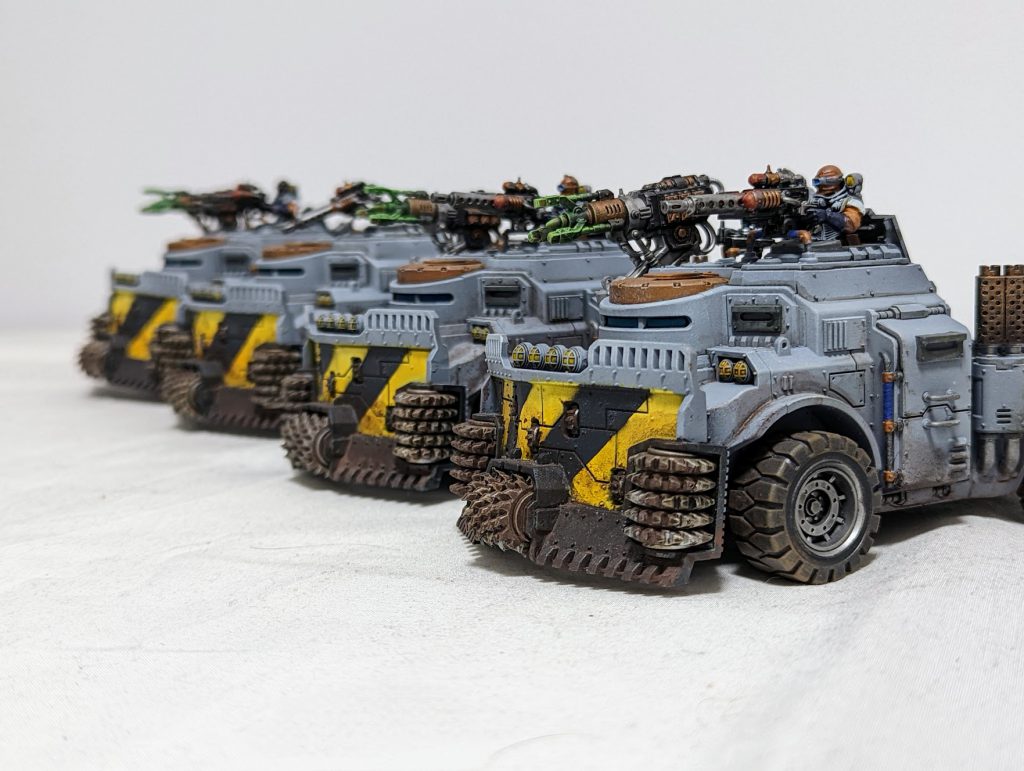
Are you awaited among the Star Children? Then saddle up, and be witnessed by the Patriarch as we ride eternal, rusted and brown in a detachment focused on bikes, buggies, and bulldozers. Bringing a war convoy of improvised industrial vehicles carrying wasteland mutants flanked by speedy bikers makes this undoubtedly the coolest of all possible cults, but the Outlander Claw is nevertheless focused on boosting datasheets that don’t have access to the army rule which is a bit of a heavy lift.
Detachment Rule – Rapid Takeover
Double the OC of Mounted and Vehicle units, and Atalan Jackals get sticky objectives. In a faction not known for staying power, this is an interesting way to boost objective play for a detachment that probably doesn’t get much value from OC40 neophyte blobs. If you go first you’ll be able to sticky all of the no-man’s land objectives with your 9” scouting Jackals, while going second you can steal objectives with fewer models before boosting away to safety using mobility and durability-focused stratagems. Of note here is that Rockgrinders are OC6, while a pair of Ridgerunners is OC12.
The combination of sticky objectives and high-OC vehicles means that your opponent must both remove your units from the objective and stand on it themselves to deny your points. That won’t be easy when their path is blocked by swarming bikes and the usual gamut of GSC lone-operative tricks. A lone Kelermorph threatening a battle-shock test during your opponent’s turn can thwart their efforts to un-sticky your objectives and force additional resource commitment, as can a Saboteur slaying a chaff unit with her mine. This is true for any stickied objective, but the impact is higher in this detachment since Jackals will have a much easier time achieving it early than Neophytes.
Enhancements
On the subject of mobility, Serpentine Tactics can only be taken by a Jackal Alphus, and lets its unit shoot in a turn in which it fell back. This is a nice return to the 9th edition days when Jackals could fall back and shoot innately. Jackal shooting isn’t particularly exciting this time around, but now with the Demolition Run ability changed to work on fall back and advance moves it means that getting bully charged by a Rhino won’t remove your Jackals from the game.
Cartographic Data-Leech can be carried by any character, and offers a boost to transported units. It improves by 1 the Ballistic Skill of weapons fired by the Firing Deck of a transport in which this model is embarked. With demo charges no longer able to be tossed over the gunwales of our sweet rides, the primary beneficiary of this is probably the character most likely to be carrying it: the Benefictus. Two lascannon shots that ignore cover and hit on 2’s is nothing to sneeze at, and combined with the special weapons from an accompanying neophyte squad this provides meaningful ranged firepower from a Goliath.
For maximum hilarity you could load three Benifictuses (Benificti?) into the same transport to create the Brain Bus: Six lascannon shots that hit on 2’s and ignore cover. It seems like a bit of a meme, but delivered out of strategic reserve it’s a pretty nasty tool for dealing with hard targets without invulnerable saves (remember that combined with a Ridgerunner this trivially becomes AP-4 ignoring cover). Space Marine players everywhere will look at the book cost of the units involved and laugh while gently stroking their Double Eliminator+Impulsor combo, but we’re hopeful that costs will come down when the book drops.
Starfall Shells equips on a Jackal Alphus, and if the Alphus hits with its sniper rifle the target suffers -1 to hit on all of its attacks until your next shooting phase. Given that the Alphus’ other ability is enabling re-rolls of 1’s to hit, generally you’ll want to target units you plan to kill rather than units that you expect to survive. Since the Alphus can shoot and scoot it’s not a bad harassment tool, but you’ll probably only buy it if you’ve got an awkward number of points to spare. It is cheaper than a Magus for the same effect, so it’s got that going for it.
Assault Commando sounds like a badass ability, but it’s a little bit awkward to use. Any character can take it, and it allows you to re-roll the hit roll for ranged attacks made by the bearer’s unit if it disembarked from a transport this turn. Given that a Primus already re-rolls all hit rolls, once again the obvious choice here is a Benefictus, this time leading a unit of demo charge acolytes. The re-rolls combine nicely with the Lethal Hits the Benefictus provides, and demo charge acolytes are probably the only unit you’d ever intentionally disembark for the purpose of shooting (they can also take hazardous hits for the Benefictus when his brain hurts from blasting too many fools). Look for this team riding in a Rockgrinder to clear a path for their ride to charge through.
Stratagems
Along Shadowed Trails is the Outlander Claw’s iteration of the blip shell-game stratagem. Use it when your opponent pops your blip, and then put the blip anywhere you want subject to the Jackal placement restriction of being within 6” of a board edge. That blip is then only usable by Jackals. This is deceptively powerful, as it allows you to be aggressive with blip placement and then punish your opponent for extending to deal with it, either by shifting backwards or by changing flanks entirely. Bonus points for layering multiple blips, so that a melee unit can threaten the aggressing enemy unit from the close blip if they ignore it, or the far blip if they aggress into the first while your bikes reposition.
Devoted Crew brings back another 9th edition ability, allowing either a Rockgrinder or Goliath Truck to subtract 1 from incoming damage until the end of the phase against either shooting or melee. This is a welcome boost in durability for the key pieces, and just reminding your opponents of its existence can be handy to discourage your opponents from shooting past your bikes at the bigger units.
Close-Range Shoot-Out is a situational tool that probably won’t see much use, but may come in handy in a pinch. Pick a Mounted or Vehicle unit in your shooting phase, and that unit gets Lethal Hits against targets within 18” until the end of the phase. None of our units have sufficient volume of fire to make this a reliably output tool, but when you need to squeak out a kill against a tough target this can let a unit of ridgerunners or a loaded Goliath get over the hump.
Rapid Feint is a reactive move, letting a unit of Ridgerunners or Jackals make a normal move up to 6” in response to an enemy unit finishing a move within 9”. Played defensively, you can use this to run away after forcing an opponent forward to stop your Jackals from stickying an objective, or offensively to close the bars on Outrider Jail after zooming 21+” forwards with either Jackals or Ridgerunners on turn one to further impede their movement. Given the large base size of Jackals, the amount of ground you can cover with a long chain is massive, and unwary opponents will find themselves unable to maneuver if they don’t have the mobility tools to escape.
Deft Maneuvering is a major durability boost, offering a unit of Ridgerunners or Jackals a 4+ invulnerable save against ranged attacks until the end of the phase. Given that Jackals have Stealth now, and Ridgerunners have access to a free use of the Smoke stratagem through the flare launcher, that creates a -1 to hit, 4++ target that will absorb significantly more firepower than the base datasheets. Use this to save your scoring pieces, reinforce the jail, or otherwise frustrate your opponent.
Encircling the Prey is a crucial repositioning tool, allowing you to pick a Mounted or Vehicle unit wholly within 9” of a board edge and not within engagement range, and put it back into reserves. This was a critical element of the Index playstyle, and it returns here in a more restricted form. A Goliath full of Neophytes or a unit of Ridgerunners can potentially be an irritating problem for your opponent to deal with as it relocates to exploit a hole in their screening or your own collapsed flank, particularly when it’s shielded from reprisal by a wall of respawning bikes.
Overall
Outlander Claw offers fun tools for living out your Mad Max dreams, with all manner of movement trickery to ensure Fury Road is whichever way your opponent drives home. Unfortunately it lacks the raw output tools of the other detachments, so it’s dependent on skilled positioning, high-OC, and shrewd use of defensive strats to avoid being overrun by the melee meta it’s releasing into. That’s on-brand for GSC, but it’s hard to call whether this will be competitively viable until we see points values. What we can say is that it’s really really cool, and the overall gameplay loop of either pinning your opponent in their deployment zone or flowing around their push to contain their heavy hitters while whittling their edges should prove to be a lot of fun.
Brood Brother Auxilia
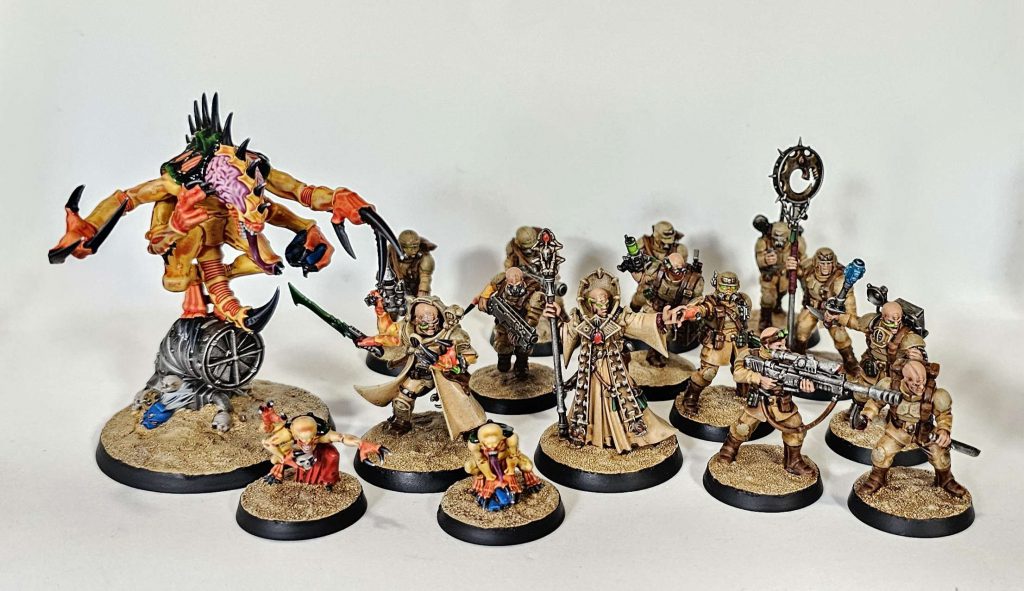
The 10th Edition Detachment model shows its strengths here, giving us the biggest shake up to Brood Brothers rules for years, and giving you an opportunity to play them as a fully integrated army. This is a really cool detachment, and hopefully we’ll see lots more stuff like this as 10th Edition plays out.
Detachment Rule – Brood Brothers
First up, obviously, you need rules for putting Astra Militarum units into your army. The Brood Brothers rule allows you to spend up to half your points on these, with the standard list of exclusions – no Epic Heroes and no abhuman/Tempestus/extra-zealous stuff. You also can’t pick a Warlord from the Astra Militarum part of your army. All units lose the Voice of Command. Despite that, Kasrkin are not excluded, and I’m reliably informed that most events have been ruling that they can still use their self-order up till now, which makes them very nice with some of what’s here.
At baseline, is there stuff you actually want from this? Some things, definitely. GSC builds from the Index have already made good use of Catachans in transports to provide cheap early board presence via their Scout move, and that doesn’t feel like it goes away. At the other end of the spectrum, Cults don’t really have any chunky tanks that can counterfire into enemy shooting, and particularly with the reduction in lethality of demolition charges in this book, that can sometimes let enemy big stuff be more aggressive than is really helpful. I can’t believe I’m saying this, but the Leman Russ Vanquisher looks like it could be pretty potent in this detachment, providing a relatively cheap set of hulls that creates a very real threat to the foe. You could go bigger too with a Dorn, but I think at that point you start running into the issue that without Orders, you don’t get the right amount of bang for your buck. The Vanquisher feels like it could genuinely be the sweet spot here, what a time to be alive.
Detachment Rule – Integrated Tactics
Now you’ve got your Astra Militarum stuff, it’s time to use them. When you shoot with an Astra Militarum unit, you can choose for them to focus all their fire on one target within 18”. If they do, then for the rest of the phase, any Genestealer Cults unit that shoots at them gets +1 to hit. This is pretty cool, and gives you some serious boosts when focusing something down. It also creates an interesting tension – you get the payoff with Cults stuff, but need to bring enough Astra Militarum units to set it up (though they can be quite small). It definitely means that cheap Astra Militarum transports like Chimeras and Tauroxes are great in this detachment, as they can set this up at minimal cost.
Enhancements
Four different options for GENESTEALER CULTS INFANTRY here, which is a little bit of a shame – it would have been cool to see some picks for the Militarum.
However, the first does buff up Astra Militarum – it lets you pick an ASTRA MILITARUM INFANTRY or MOUNTED unit within 9” for +1AP in the shooting phase. That’s a fairly considerable boost, and could be used both to try and get some value out of mass lasguns, or maybe to boost up Field Ordnance or Heavy Weapon Teams, making the former somewhat scary into power armour, and the latter better at clearing hordes. Combine that with a Scout Sentinel to ignore the hit penalty, and you might be cooking (and the Sentinel has some other synergies with the detachment). It is a shame that many buffs in this book (e.g. Crossfire from the Ridgerunner don’t work cross-faction, or this would start looking really potent. Unfortunately, as is, it’s very expensive at 30pts, and I’m not currently convinced there’s a big enough payoff to go with it.
Next up, Adaptive Reprisal lets a Genestealer Cults unit within 9” of the bearer (presumably including the bearer themselves) perform a Heroic Intervention for 0CP once per turn. That’s a surprisingly generous range to work at, and making this very broad is cool, but Heroic Intervention is never quite as exciting as it sounds. All that being said, you can now take this on a Patriarch, and it’s only 10pts, so you could slot it in just cause you have some leftover budget (also nice on an Abominant or Biophagus with Aberrants)..
I think you’re more likely to be upgrading your Patriarch with the next one, The Hero Returned, which provides +1 to OC (for the bearer’s unit) and Ld for 15pts. OC2 Stealers seem fun, and you could also get good value on this with some Aberrants, making them much harder to steal a point from.
Finally, we get Firepoint Commander, which provides Overwatch on 5+ to the unit. This feels like it could be excellent with a big Neophyte unit and a Primus, because 5s re-rolling on Overwatch is genuinely threatening. This feels great for an Ork-heavy metagame, and valuable in general.
Stratagems
Our first Stratagem here is the Brood Brothers spin on “rescue an Ambush Counter”, and it’s one of the better ones. You use In the Shadow of Iron when the enemy ends a move within 9” of an Ambush marker, and it allows you to pick the marker up and place it wholly within 6” of one of your Astra Militarum vehicles (and outside of 9” from the enemy). This is nifty, as it’s pretty flexible in where you can place the unit, and it’s a good reason to bring cheap Militarum transports.
The next option lets your Astra Militarum units get in on Cult Ambushing. When a REGIMENT INFANTRY unit (excluding Characters or Artillery) gets destroyed, you can chuck them into Cult Ambush on a 3+. On the one hand it sucks that there’s a failure case here, but on the other if you get to respawn Kasrkin (your main target for this) it can be fairly back-breaking. I really feel like this should just work – like a lot of Cult Ambush tricks, the fact that you often have to wait two turns before meaningfully doing stuff with the unit again means the window for getting big value is small, and makes this much less scary than the Militarum equivalent.
Cool synergy stuff up next in Suppress and Overwhelm, which lets you set up an enemy unit for melee doom after an Astra Militarum unit hits them. They can’t use Overwatch for the rest of the turn, and you get a free Charge re-roll whenever a Genestealer Cults unit charges them. This is pretty neat, though slightly held back by the fact that savvy opponents will usually be able to Overwatch in the Movement Phase when this is going to matter. The fact that you get re-rolls as well does mitigate that somewhat, and there’s definitely use cases here.
Next, and running you a somewhat eye-watering 2CP, is Acceptable Losses. This lets an Astra Militarum unit shoot into a combat your Genestealer Cults units are involved in, at the cost of potentially inflicting some Mortals on them (d3+1 on a 5+). This is cute, and can definitely unleash nasty surprises, but it should also definitely cost 1CP.
Symbiotic Destruction provides a nice generically useful shooting buff – you pick an Astra Militarum and Genestealer Cults unit, both have to concentrate their fire on one target, and in exchange you get re-roll 1s to Wound. This aligns very well with the Detachment Rule – as long as you shoot with the Astra Militarum unit first this gives your Cult unit the +1 to hit, and then the Wound re-rolls help you punch up a bit. Great for helping Neophytes and Acolytes get the job done, and also nifty with some Kasrkin self-ordering for three-shot plasma guns.
Finally, the coolest option here by far is A Dark Network. This is a new flavour of reactive move, usable by Astra Militarum or Genestealer Cults units (excluding Vehicles, sadly) and letting them make a Normal Move of 6” after an enemy unit sets up from Reserves within 12” of them. This is enormously strong against any foe who’s planning on using alpha units out of Deep Strike, as it can completely prevent a charge, and also has some value in potentially preventing the opponent setting up where they want to. While the obvious use of this is just to hide, if you activate it on a big unit after the opponent drops their first Reserves piece and head towards them (or just spread out) it can mess with their ability to place further units. It’s also really good with Lone Operatives, as it stops the enemy being able to shoot them out of Deep Strike. One of the best Strats in the whole book, and a big draw to this detachment.
Overall
This detachment feels like it’s really close to being good, but I worry that it doesn’t provide quite enough of a proactive lift in a book where that’s much more important. That could be off base – I can definitely see that if you spend ~700-800pts on three Vanquishers, a Scout Sentinel and a Chimera each of Kasrkin and Catachans then that could form a decent anchor for a combined arms Cult build – forego Acolytes as damage dealers, and just focus on big Neophyte blocks with Primuses, and finish with a couple of melee hammers making use of the Enhancements. Probably not quite enough, but maybe not miles off either.
Datasheets
There’s quite a few Datasheet changes in this book, and more than a lot of books it’s very hard to fully evaluate this without knowing the final points costs. Bluntly, this is because quite a few of the changes here are nerfs, filing the sharpest edges off Aberrants, Neophytes and demo charge Acolytes. If the points are right, that could be fine – one of the challenges with Index Cults was that their go units were so fantastically deadly that pricing them correctly was almost impossible. If appropriate drops come alongside this, things are OK. If not…this could be pretty rough. The optimistic news on that front is that the direction of travel in the book costs is correct – quite a few things are substantially cheaper than their most recent MFM incarnation.
New Datasheets
We have one completely new Datasheet here, and one weapon-based split on Acolytes, who now come in either a shooty version with hand flamers and demo charges or a melee option.
The new datasheet is the Benefictus, who has read more theory than anyone else in the revolution and has a gigantic brain to show for it. They’re a leader that can join any flavour of Hybrids, and provide Lethal Hits on ranged weapons. That’s merely OK, as unfortunately you can’t double these up with a Primus, and for big units that’s definitely what you’d want to be doing. They do also, however, provide some extra firepower in their own right, with their brain being an 18” Ignores Cover lascannon, and getting a second shot if you risk going Hazardous. That’s a fairly spicy prospect, as the Benefictus only has 3W, but if you’re going for a 3” drop with Acolytes via Tunnel Crawlers in the Host of Ascension, you both aren’t expecting to survive very long and can offload a failed test to a chump with a demo charge. The other option, and more broadly applicable, is to stick one in the back of a Rockgrinder or Truck, as here the Hazardous can be absorbed by the ride itself if it goes wrong, and adding two lascannon shots seriously ups the threat profile of any of these. Their book price seems a little high at 80pts, so hopefully it comes down slightly when the MFM updates – if it does, both options here seem plausible, the latter particularly in combination with the Cartographic Data-Leech in the Outlander Claw.
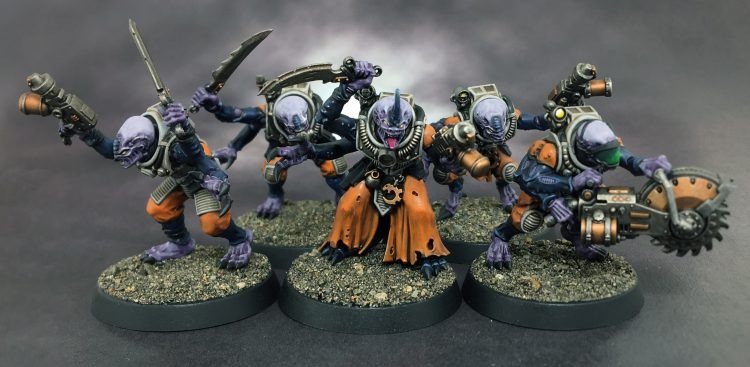
Credit: Pendulin
Acolytes next, where the news is somewhat mixed. The good news is that for all intents and purposes, you’re gaining a datasheet here, as these are currently always taken as equipped in the shooty version, and the melee option is legitimately interesting. These are very unusual in that getting the box lock treatment actually helps them – because you get one of each melee weapon per box, you can take three heavy mining tools per 5, and these are 2A S5 AP-2 with Anti-Vehicle 4+ and a tasty flat damage 3. Being able to cram six into a full unit gives you something the army was missing in the index, which is a mid-cost melee threat that’s compatible with the core leaders. These are also where gaining a CP on a 4+ if you’re holding an objective now lives, as Neophytes sticky objectives instead. Much more interesting than they were in the Index, overall, and particularly scary with a Biophagus in the Biosanctic Broodsurge.
The bad news in exchange for this is that the shooty version gets toned down substantially – demolition charges are now just d6 shots, and drop to S9. The latter point is mitigated a bit by their re-rolls changing to rr1s to Wound all the time, and full re-rolls to wound against a target on an objective. That does probably keep them in use despite their reduced stature, as there’s plenty of stuff that needs to remain very afraid of the shooting threat they present.
Updated Datasheets
Characters
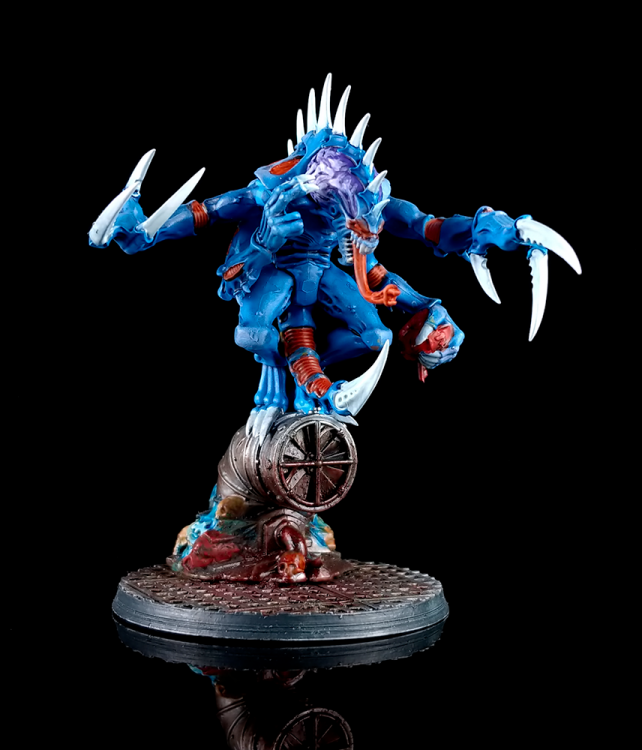
A big, very exciting change up front – the Patriarch is no longer an Epic Hero! There’s a new rule that you can still only take one, but that means you can now Enhance them to your heart’s content. Well, take one Enhancement anyway – and you should, there are plenty of nice combinations. They can also ride in Transports now, giving you an option to stage them for a counter-charge.
Many other options get tweaks of varying size. Among Leaders, the changes are mostly quite small, and the Primus (still one of your top picks) doesn’t change, so the impact may be limited.
In terms of minor updates, the Biophagus gets a mild decrease in the power of their Alchemicus Familiar, now giving +1 to Wound against INFANTRY instead of Anti-Infantry 2+, and the Iconward gets some updates to be fully compatible with new and improved Hybrid Metamorphs. Slightly bigger changes come on the Magus, but she’s still fairly weak – instead of Psychic Attack protection she now lets you un-Battle-shock a unit once per game, and Mind Control gets a sidegrade – the base range is longer (18”) and doesn’t need Line of Sight, but the worst-case outcome for opponents is getting -1 to Hit and Wound, not being unable to shoot. Being able to throw this around from behind a wall does add utility, but it’s still not something the army is interested in – you need everything to be pulling in the direction of methodically sweeping up the foe, not marginally debuffing them. She does get a 5+ Invulnerable Save now, which is neat.
More exciting for throwing out from behind walls is the new version of the Clamavus, who lets you force a Battle-shock test on a target within 18” in your Command Phase. That’s a good bit of reach, and honestly in combination with their Scrambler Array you might just take these solo – Indirect levels in the metagame are pretty low, and just sitting behind a wall forcing Battle-shocks and screening Deep Strike is super annoying. Last up for Leaders, the Nexos gets a tweak to both abilities – Battlefield Analysis now reduces a Stratagems’ cost by 1CP instead of making it free, which is a debuff on paper, but maybe indicates how these abilities might work in future, in which case please GW take away the Battle Tactic limitation, we’re begging you. Past that, a given Cult Ambush token can only be moved once per turn, rather than multiple Nexos being able to give a token the zoomies.
Finally, the Leaders for more unique units both get tweaks. The Jackal Alphus is an easy one – she gets Stealth, which the Jackals also pick up, which is a nice straight buff. The Abombinant gets a bigger change. The exciting bit is that they get a fourth attack. Huzzah! Less good is that they’re slightly squishier (Feel No Pain 5+ instead of 4+) and hand out Fight on Death on 4+ instead of Sustained Hits. That’s a net downgrade overall, but the extra attack matters a lot when the Abominant stands back up, as it means the threat they present is more substantial. In a melee-heavy metagame, Fight on Death could also end up mattering more than Sustained anyway.
Various Lone Operatives get bigger changes. The Saboteur is a loser here – she gets the same debuff to demo charges as everyone else, and here explosives now trigger at 9” instead of 12”. This is huge for a Lone Operative, as it means that enemies can get within strike range without risking Mortal Wounds. She gets a 5+ Invulnerable Save in trade for this, but it’s not a good swap – most things that were going to kill her are still going to, and she’ll take fewer foes with her.

Happily, for filling out the role of cheap Infiltrating Lone Operative, the Sanctus gets a lot better. Instead of Advance/Shoot/Charge, they get one of two abilities depending on which weapon it takes. With the rifle, they get a 6” reactive move when the enemy ends within 9”, always incredibly annoying to handle on a Lone Operative. The rifle also jumps to base S7, nothing to sniff at! Meanwhile, with the knife they now cannot be Overwatched, and since that also goes up to D2, it’s now a relatively serious threat. Finally, the Psychic Spoor ability changes to be full hit and wound re-rolls against a chosen target instead of Devastating Wounds, which is super nasty with the dagger in particular. Expect to see a lot of these out and about, potentially even both variants – while the dagger build is definitely a one-and-done missile, if you pick the right target for the Spoor they can legitimately scare a key Leader from coming into a big part of the board. The rifle is obviously the better utility pick though, and it’s very possible people just stick to that.
Also shaken up in the lone gunmen department is the Kelermorph, and this feels like a boost overall. Their guns sidegrade heavily – no more Sustained or Precision, but a lot better on base rate, jumping to S6 AP-2. That removes the threat to high-roll enemy Characters, but also substantially reduces the risk of doing nothing at all into many targets. It also pairs well with their new special abilities, which tend to draw them away from trying to murder Characters. The first of these is that once per turn, one Kelermorph from your army can force a Battle-shock test on a target they hit. So far so good, but that really pops off with Hypersensory Abilities. This triggers when an enemy ends a move within 12” of the Kelermorph, and allows them to shoot that enemy then make a reactive move of d6”. This is absolutely hilarious, and even better when you remember that you’ll force a Battle-shock test on the thing you target, as that ability is worded so it does still function when used in this way. This makes a single Kelermorph standing right next to a wall near a key objective intensely frustrating for the opponent to try and handle – there’s no way to engage with them without triggering this ability, and if you’ve only got one unit that can move onto the Objective, well – do you feel lucky, punk? This is kept in check by the Battle-shock test only triggering from one per turn, but you should still see a Kelermorph in lots of lists because of it.
Infantry & Mounted
We’ve covered Acolytes already, so Neophytes are the natural place to go next. These get a few changes, with the first being that they now create sticky objectives, which is certainly handy. It plausibly creates a bit more of a use for the odd unit of 10 either in Deep Strike or a cheap Transport, as it creates pressure on opponents to try and get them off a point fast (and it’s also always useful to sticky your home objective. The other changes are less welcome, reducing their lethality a fair bit – the box-lock fairy has visited, limiting them to one of each special/heavy weapon per 10, and the seismic cannon has lost a couple of shots, meaning you’re going from 24 seismic shots on a unit that’s going big to a mere 8 (though you will now, presumably, have a couple of mining lasers to go with). That’s a big change, and the hope has to be that their points change accordingly (encouragingly, the book points are 20pts cheaper per 10 than the current price, so this could well actually happen).
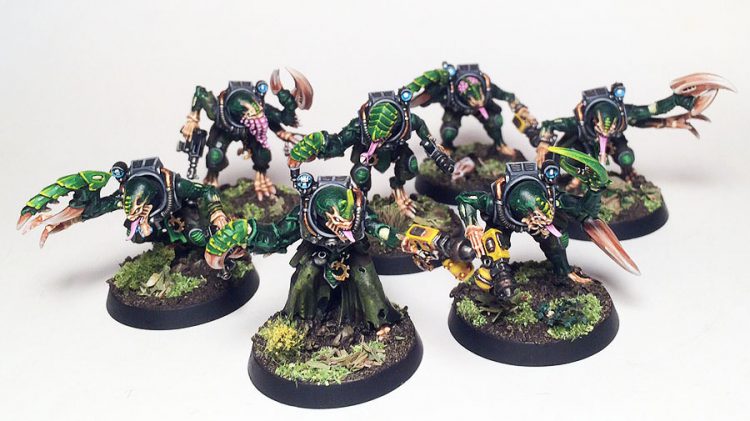
Things are better as we move over to Hybrid Metamorphs, who gain a 5+ Feel No Pain (always nice) and shift their Fight on Death for a Khorne Berzerker-style move towards the closest enemy (including into Engagement Range) after being shot and losing any models. This is d6” normally, but if you choose to keep their guns as autopistols instead of hand flamers it becomes an automatic 6”. This is both a cool way to add a trade-off on taking the obviously better gun, and a genuinely interesting option – these will rocket across the table if the enemy tries to pick them off a few at a time, and synergises well with the Feel No Pain adding variance to how quick they die. A good change overall, which might get these some consideration in lists, particularly Biosanctic Broodsurge builds alongside a Biophagus, or just in general with an Iconward for a tasty 4+ Feel No Pain. Stick them in a Truck to safely benefit from the Scouts for staging and you’re in a nice spot.
Also good in that, but also taking a big hit, we have Aberrants. These are significantly toned down from their index stats, dropping to S7 D2, and now only having a 5+ Feel No Pain. That’s obviously a huge hit, and the question once more will be whether they’re cheaper enough to still be worth it (the book points here are -30pts per 5 from the last MFM, but it probably needs to be a bigger drop than that).
Lastly for filling out your revolutionary horde we’ve got Atalan Jackals, who are mostly fairly big winners.They get back Stealth, which they’ve functionally had in all pre-10th incarnations, and their Outrider Gangs ability now only needs them to be wholly within 9” of a Battlefield Edge when arriving from ambush rather than 6”, giving them a bit more flexibility. The only cost on this is that their Mortal Wounds are now capped at 6MW when they trigger (which is above their average anyway), and they only get two power weapons per four. Still a decent and welcome upgrade overall.
Vehicles
Last up we have the three Vehicle Datasheets. The dependable Goliath Truck gets a small debuff, dropping to Firing Deck 6 and seeing the same downgrade to its demo charges as in other places, but you’ll still use them – they already turned up for board presence in the odd build, and the wider range of detachments makes them a much more important cog in the engine of the army, as not all lists will be as all-in on Deep Strike shooting.
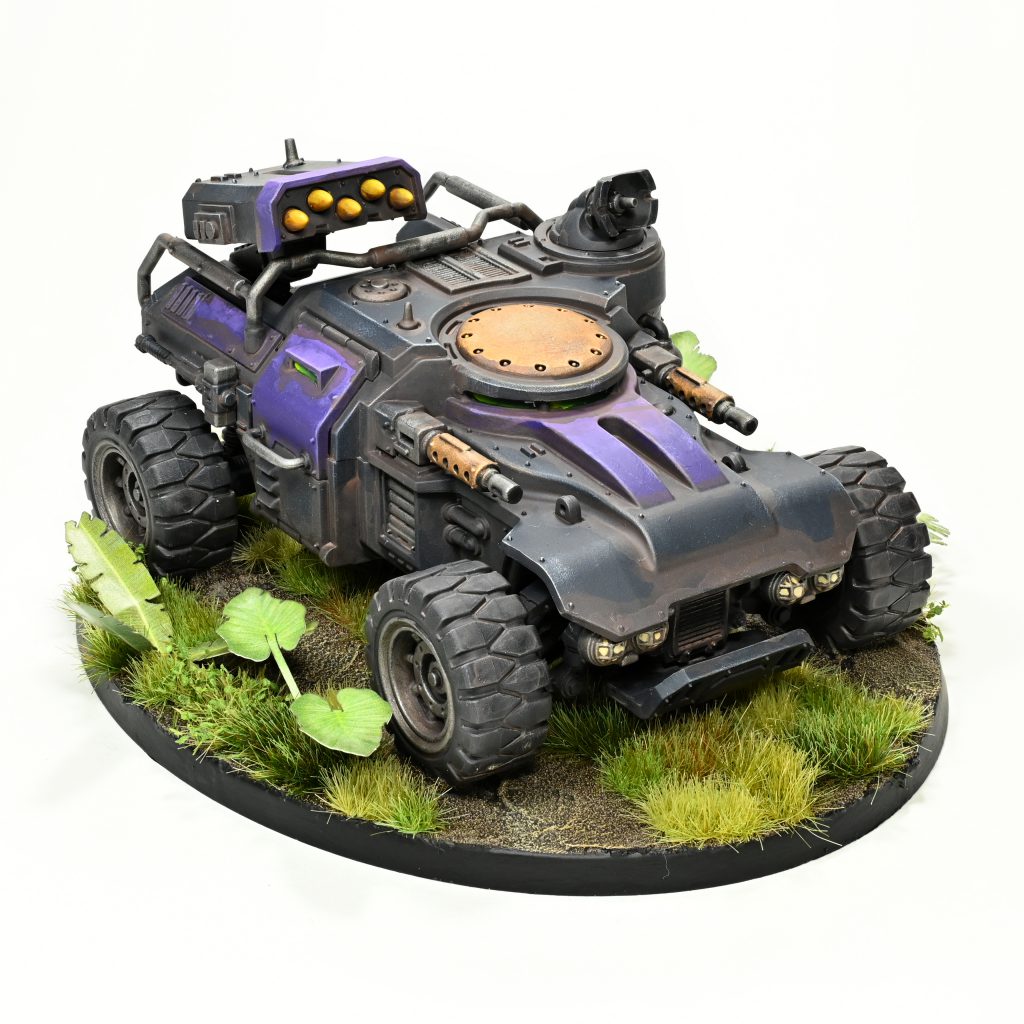
The Achilles Ridgerunners get a small but very relevant change, which is that taking a Flare Launcher now both gives the SMOKE keyword and lets you use the Smokescreen stratagem for free. That feels like it makes a pair of these with mining lasers as a direct fire threat an actual consideration, because effectively always having smoke on makes them proportionately tough for their price.
Finally, moving on to the Rockgrinder, this gets a new line in terrorizing enemy units – rather than impact Mortals, it now forces a Desperate Escape test on any non-Monster/Vehicle foe that falls back from it, at -1 if they’re battle shocked. The melee weapon also goes up to 8A instead of 6A with Sustained, which nets out as a buff most of the time. Unclear if this is filling a role you actually want after all that, but it’s cute.
How They Will Play
Cunningly. While the exact distribution of tricks and traps in this book has been shaken up somewhat from the Index, any successful army is going to trade off two things – denying the opponent through cunning ploys, and creating situations where your units can punch above their weight. The top end lethality of your stuff is down, so you probably can’t plan on reliably just tabling your opponent over turns two and three if they overextend, but you probably will have more units on the board than before, along with a broader range of lethality/cost tradeoffs to build with. Sneaky play from the Kelermorph and Sanctus can lure opponents into dangerous positions, whereupon a mighty pounce from Acolytes, Hybrids or Aberrants, or a hail of fire from Neophytes, can cut the foe down. Different detachments favour a different set of toys for bringing down the hammer, but the overall principle remains the same – bait a trap, then unleash your horrors.
Final Thoughts
TwoHorse: Overall, this checks all the boxes we hope to see from a GSC codex: An inscrutable playstyle defined by unique new mechanics, a broader landscape of viable units, and the inevitable return to the bits box as the correct weapon options change for dozens of models once again. Jokes aside, this codex lays the groundwork for a diverse and interesting faction, having hopefully rounded off the balance knife-edge of “ludicrously lethal” and “endlessly respawning” that caused GSC success to seesaw since the launch of 10th edition. I’m confident that these five thematic detachments offer the tools needed to cast off the oppressor and usher in the arrival of the Star Children, and I’m cautiously optimistic that the new datasheet landscape will allow points changes to do the balance heavy lifting in the future.
Wings: This book is odd, overall. There’s certainly some overlap with Adeptus Custodes, which felt like a massive overreaction to the power of the Index, but it’s not as bad of a story, because here there’s some solid movement in the other direction as well. I don’t think that both the lethality of the Battleline stuff and the Army Rule needed to be hit as hard as they were simultaneously, but the flipside is that the Detachments here have clearly had some real love put into them, all bringing pretty interesting stuff to the table. There’s also some very positive Datasheet changes amidst the nerfs, with the Sanctus, Kelermorph, melee Acolytes and Metamorphs all standing out.
That’s good, because it means if this lands with a bit of a whimper (and I think that’s the realistic likely outcome), it’s at least fixable with points and (probably) some sort of boost to the Army Rule, which is just too unreliable as it now stands. With both this and Custodes, fairly aggressive changes have been made to things that weren’t really the driving cause of the problem. For Custodes, 10-model Custodian units and easy Fight First access just made the game too hostile to other melee armies, and you could probably have stopped hammering the faction after you’d cleared those out. For GSC, almost all the major problems with the index were downstream from Acolytes and Neophytes being spectacularly too deadly when they dropped, plus Return to the Shadows functionally removing a key balancing risk of the Army Rule. You probably didn’t need to nerf Cult Ambush that much once those two things were fixed, and I suspect in future balance Dataslates we’re going to get the exciting new experience of watching it gradually creep back to what it was in its original incarnation.
I should stress amidst all of this – I quite like this book! It has fun, well thought out detachments, some cool bits of datasheet design, and does fix the true problems with the Index as well as the downstream ones, but unless the points are exceptionally generous I think this is going to land underwhelmingly.
That’s it for our look at Genestealer Cults, and inevitably there will be some sort of bonkers trick that we’ve missed which will be used to confuse and confound the metagame. Make sure to also check out our reviews of the Pariah Nexus mission pack and the Adepta Sororitas Codex.

![[40k] Competitive Innovations in 10th: Death Beckons pt.1](https://d1w82usnq70pt2.cloudfront.net/wp-content/uploads/2020/01/Analysis_Banner.png)
